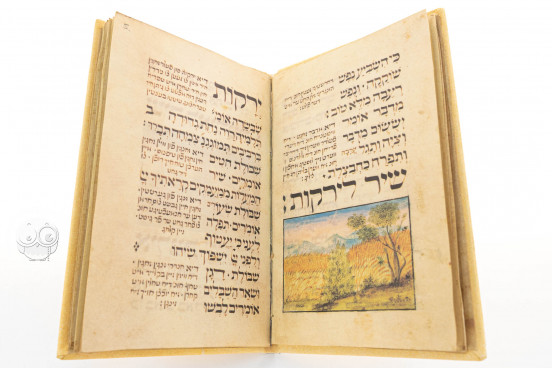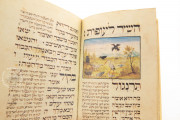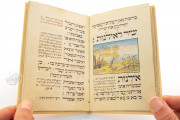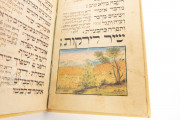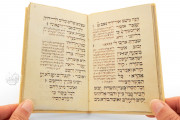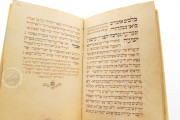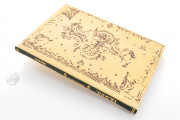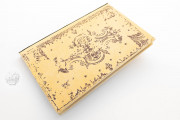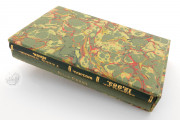The Perek Shirah, or "Chapter of Praise," is a compilation of eighty-four verses concerning the natural elements, plants, and creatures of Creation as described in the Tanakh (the Hebrew Bible). The verses are framed by a midrash, or commentary, that teaches that the natural world is a source of philosophy and ethics. The text is presented in Hebrew with a Yiddish translation. The manuscript, created in the 1740s by Aaron Wolf Herlingen, working in Vienna or Bratislava, is embellished with five miniatures.
Each explicated verse, many drawn from the Psalms, is "spoken" by a different aspect of the world. The verses of the opening song emanate from voices such as those of the heavens, celestial bodies, clouds, lightning, bodies of water, fish, and a sea monster. Plants, birds, and animals speak the verses of the subsequent songs.
Miniatures of God's Creation
The paintings gather the various natural elements, plants, and creatures mentioned in the text into five delicately painted landscapes with thin black painted frames. The first miniature depicts the heavens, celestial bodies, the Garden of Eden, seas, and fields, as well as the humble frog (fol. 1r). Other miniatures introduce the subsequent sections of the text: the Song of Vegetation (fol. 4v), the Song of the Trees (fol. 5v), the Song of the Birds (fol. 8v), and the Song of the Animals (fol. 12v).
Surprise Appearances
The opening miniature, ostensibly devoted to the celestial bodies and Paradise, includes three frogs, many fish, and a delightful sea monster. The miniature for the Song of the Trees depicts a confrontation between a snake and a cat, two creatures among the song's speakers. The identifiable creatures in the Song of the Animals painting include a lion, a bear, and a dog—the last with a bright red collar.
A Modern Manuscript in a Long Tradition
The tradition of writing on parchment with a quill pen continued in the Jewish tradition after printed books became widely available in Europe. Handwritten scrolls of the Torah—the first five books of the Hebrew Bible—continued and continue to be made by expert scribes. The British Library's Perek Shirah is the product of an eighteenth-century revival in the production of manuscript codices of Jewish texts written by scribes trained in the Torah tradition.
Hebrew Text with Yiddish Translation
The Hebrew text of the Perek Shirah and its Yiddish translation are written in Hebrew Square Script. The manuscript was written and illuminated by Aaron Wolf ben Zeev (Schreiber) Herlingen, a native of Jevíčko (Moravia, modern Czech Republic) who was employed at the Hapsburg imperial library in Vienna.
Gold-Tooled Binging
The manuscript was purchased by the British Museum at a Christie's sale in 1965 and became a part of the collection of the British Library upon its foundation in 1973. Its binding, which has lost much of its color, is of gold-tooled, red-dyed parchment over pasteboard.
We have 1 facsimile edition of the manuscript "Perek Shirah": Perek Shirah facsimile edition, published by Facsimile Editions Ltd., 1996
Request Info / Price
